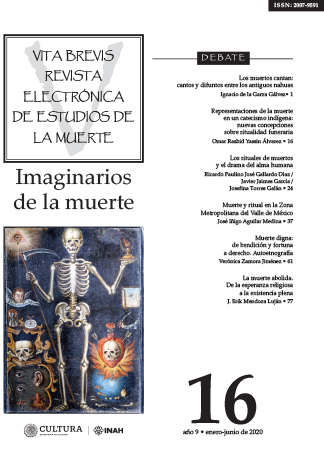Published 2024-01-09
Keywords
- Values wake,
- Burial,
- Day of the dead,
- Raising the cross,
- Novena
Copyright (c) 2020 Instituto Nacional de Antropología e Historia

This work is licensed under a Creative Commons Attribution-NonCommercial 4.0 International License.
How to Cite
Abstract
It analyzes the behavior of the inhabitants of the Metropolitan Zone of the Valley of Mexico, regarding the rites that accompany death, in an environment of wide secularization. It is considered that the ritual emphasizes both the meaning that culture and religion give it with its rites, as well as the values that consider the social relationship. And he proposes that the former are better understood and accepted by the older and the latter by the young. To investigate this, 639 individuals over 18 years of age were interviewed. They were grouped by generation: young, adults, elderly and it was found that they retain unequal preferences, young women tend to shorten the rites or consider them unnecessary, they give relevance to social ties and appreciate the food of the day of the dead; the older ones follow the rites and value prayer and being prepared for their death more.
Downloads
References
- Cantera Montenegro, Santiago, La crisis de Occidente. Orígenes, actualidad y futuro, Córdoba, Sekotia, 2020.
- City Population, “Major agglomerations of the world. All urban agglomerations of the world with a population of 1 million inhabitants or more”, 1 de enero de 2021, recuperado de: https://www.citypopulation.de/en/world/agglomerations consultada el 4 de junio de 2021.
- Domingo Moratalla, Agustín y Tomás Domingo Moratalla, “Filosofías del don. Usos y abusos de la donación en la ética contemporánea”, Veritas. Revista de Filosofía y Teología, núm. 28, marzo de 2013, pp. 41-62.
- ECDC, “Question and Answers on COVID-19”, European Centre for Disease Prevention and Control, abril de 2020, recuperado de: https://www.ecdc.europa.eu/en/covid-19/questions-answers consultada el 25 de febrero de 2022.
- Fragoso Barreto, Juana Iris, “Breve análisis sociológico sobre las transformaciones de los velorios hoy en día debido a la modernidad. El caso de dos municipios del Estado de México: Tepotzotlán y Naucalpan de Juárez”, Vita Brevis. Revista electrónica de estudios de la muerte, año 4, núm. 6, enero-junio de 2015, recuperado de: https://www.revistas.inah.gob.mx/index.php/vitabrevis/issue/view/445/520 consultada el 16 de febrero de 2022.
- Geertz, Clifford, La interpretación de las culturas, Barcelona, Gedisa, 2003.
- Hernández Sampieri, Roberto, Carlos Fernández Collado y Pilar Baptista Lucio, Metodología de la investigación, México, McGraw Hill, 2014.
- INEGI, Censo de Población y Vivienda 2020, México, Instituo Nacional de Estadística y Geografía, 2020, recuperado de: https://www.inegi.org.mx consultada el 6 de abril de 2022.
- Marcel, Gabriel, “Muerte e inmortalidad”, en Homo Viator. Prolegómenos a una metafísica de la esperanza, Salamanca, Sígueme, 2005, pp. 297-312.
- Martinón-Torres, María, Francesco D’errico, Elena Santos et al., “Earliest Known Human Burial in Africa”, Nature, núm. 593, 2021, pp. 95-100, recuperado de: https://doi.org/10.1038/s41586-021-03457-8
- Polo Barrena, Leonardo, “Sobre el origen del hombre: hominización y humanización”, Revista de Medicina de la Universidad de Navarra, enero-marzo de1994, recuperado de: https://www.leonardopolo.net/docs/Medicina.pdf consultada el 16 de febrero de 2022.
- Secretaría de Salud, “Acuerdo por el que se establecen acciones extraordinarias para atender la emergencia sanitaria generada por el virus SARS-CoV2”, Diario Oficial, 31 de marzo de 2020, recuperado de: https://www.dof.gob.mx/nota_to_imagen_fs.php?codnota=5590914&fecha=31/03/2020&cod_diario=286001
- Vattino, Gianni, El fin de la modernidad. Nihilismo y hermenéutica en la cultura posmoderna, Barcelona, Gedisa, 1987

